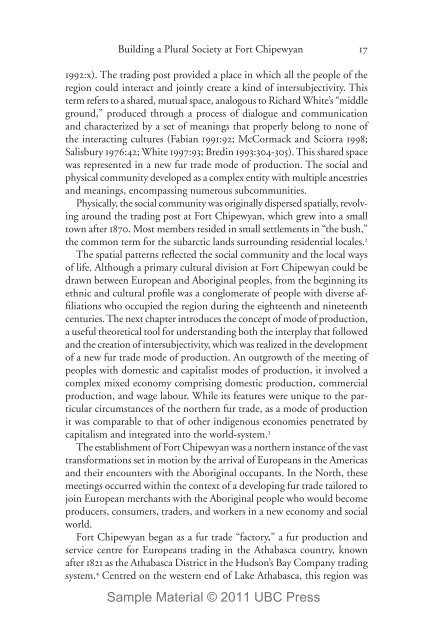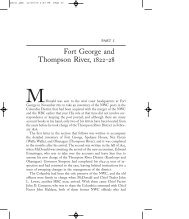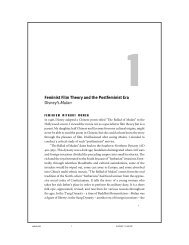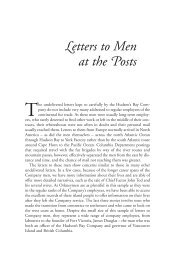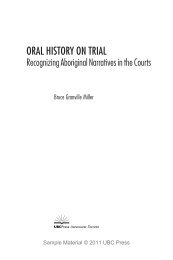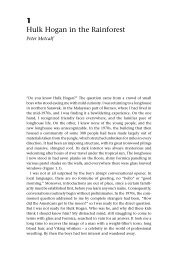Fort Chipewyan and the Shaping of Canadian History ... - UBC Press
Fort Chipewyan and the Shaping of Canadian History ... - UBC Press
Fort Chipewyan and the Shaping of Canadian History ... - UBC Press
Create successful ePaper yourself
Turn your PDF publications into a flip-book with our unique Google optimized e-Paper software.
Building a Plural Society at <strong>Fort</strong> <strong>Chipewyan</strong><br />
1992:x). The trading post provided a place in which all <strong>the</strong> people <strong>of</strong> <strong>the</strong><br />
region could interact <strong>and</strong> jointly create a kind <strong>of</strong> intersubjectivity. This<br />
term refers to a shared, mutual space, analogous to Richard White’s “middle<br />
ground,” produced through a process <strong>of</strong> dialogue <strong>and</strong> communication<br />
<strong>and</strong> characterized by a set <strong>of</strong> meanings that properly belong to none <strong>of</strong><br />
<strong>the</strong> interacting cultures (Fabian 1991:92; McCormack <strong>and</strong> Sciorra 1998;<br />
Salisbury 1976:42; White 1997:93; Bredin 1993:304-305). This shared space<br />
was represented in a new fur trade mode <strong>of</strong> production. The social <strong>and</strong><br />
physical community developed as a complex entity with multiple ancestries<br />
<strong>and</strong> meanings, encompassing numerous subcommunities.<br />
Physically, <strong>the</strong> social community was originally dispersed spatially, revolving<br />
around <strong>the</strong> trading post at <strong>Fort</strong> <strong>Chipewyan</strong>, which grew into a small<br />
town after 1870. Most members resided in small settlements in “<strong>the</strong> bush,”<br />
<strong>the</strong> common term for <strong>the</strong> subarctic l<strong>and</strong>s surrounding residential locales. 2<br />
The spatial patterns reflected <strong>the</strong> social community <strong>and</strong> <strong>the</strong> local ways<br />
<strong>of</strong> life. Although a primary cultural division at <strong>Fort</strong> <strong>Chipewyan</strong> could be<br />
drawn between European <strong>and</strong> Aboriginal peoples, from <strong>the</strong> beginning its<br />
ethnic <strong>and</strong> cultural pr<strong>of</strong>ile was a conglomerate <strong>of</strong> people with diverse affiliations<br />
who occupied <strong>the</strong> region during <strong>the</strong> eighteenth <strong>and</strong> nineteenth<br />
centuries. The next chapter introduces <strong>the</strong> concept <strong>of</strong> mode <strong>of</strong> production,<br />
a useful <strong>the</strong>oretical tool for underst<strong>and</strong>ing both <strong>the</strong> interplay that followed<br />
<strong>and</strong> <strong>the</strong> creation <strong>of</strong> intersubjectivity, which was realized in <strong>the</strong> development<br />
<strong>of</strong> a new fur trade mode <strong>of</strong> production. An outgrowth <strong>of</strong> <strong>the</strong> meeting <strong>of</strong><br />
peoples with domestic <strong>and</strong> capitalist modes <strong>of</strong> production, it involved a<br />
complex mixed economy comprising domestic production, commercial<br />
production, <strong>and</strong> wage labour. While its features were unique to <strong>the</strong> particular<br />
circumstances <strong>of</strong> <strong>the</strong> nor<strong>the</strong>rn fur trade, as a mode <strong>of</strong> production<br />
it was comparable to that <strong>of</strong> o<strong>the</strong>r indigenous economies penetrated by<br />
capitalism <strong>and</strong> integrated into <strong>the</strong> world-system. 3<br />
The establishment <strong>of</strong> <strong>Fort</strong> <strong>Chipewyan</strong> was a nor<strong>the</strong>rn instance <strong>of</strong> <strong>the</strong> vast<br />
transformations set in motion by <strong>the</strong> arrival <strong>of</strong> Europeans in <strong>the</strong> Americas<br />
<strong>and</strong> <strong>the</strong>ir encounters with <strong>the</strong> Aboriginal occupants. In <strong>the</strong> North, <strong>the</strong>se<br />
meetings occurred within <strong>the</strong> context <strong>of</strong> a developing fur trade tailored to<br />
join European merchants with <strong>the</strong> Aboriginal people who would become<br />
producers, consumers, traders, <strong>and</strong> workers in a new economy <strong>and</strong> social<br />
world.<br />
<strong>Fort</strong> <strong>Chipewyan</strong> began as a fur trade “factory,” a fur production <strong>and</strong><br />
service centre for Europeans trading in <strong>the</strong> Athabasca country, known<br />
after 1821 as <strong>the</strong> Athabasca District in <strong>the</strong> Hudson’s Bay Company trading<br />
system. 4 Centred on <strong>the</strong> western end <strong>of</strong> Lake Athabasca, this region was<br />
Sample Material © 2011 <strong>UBC</strong> <strong>Press</strong><br />
17


